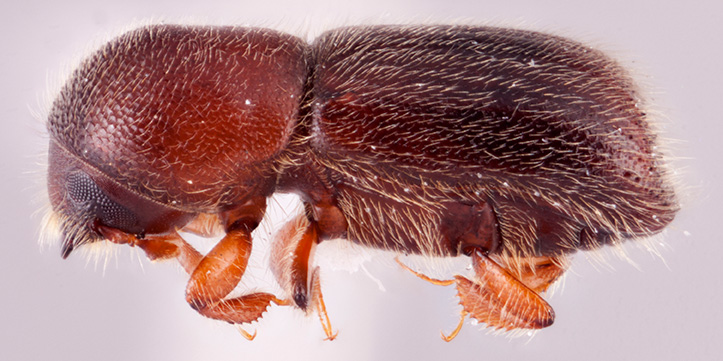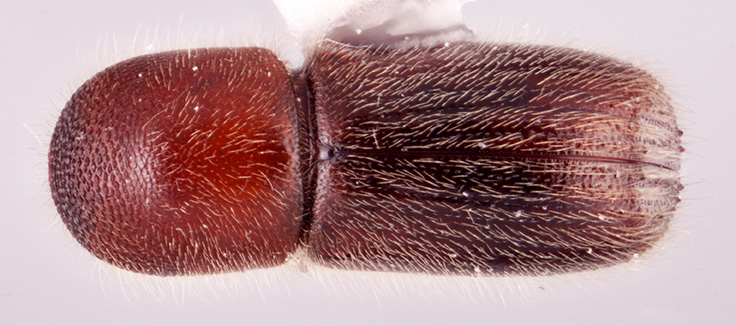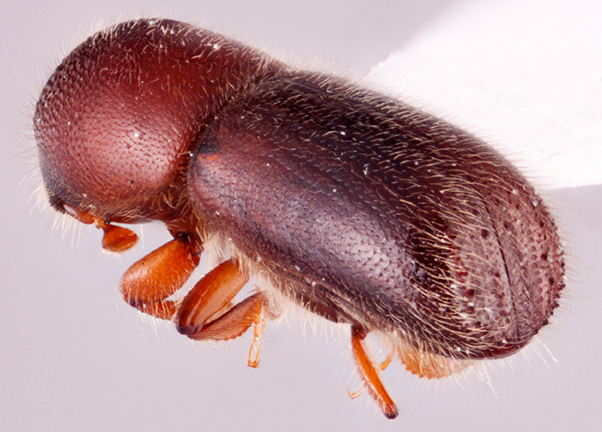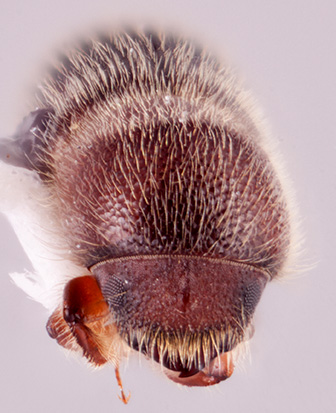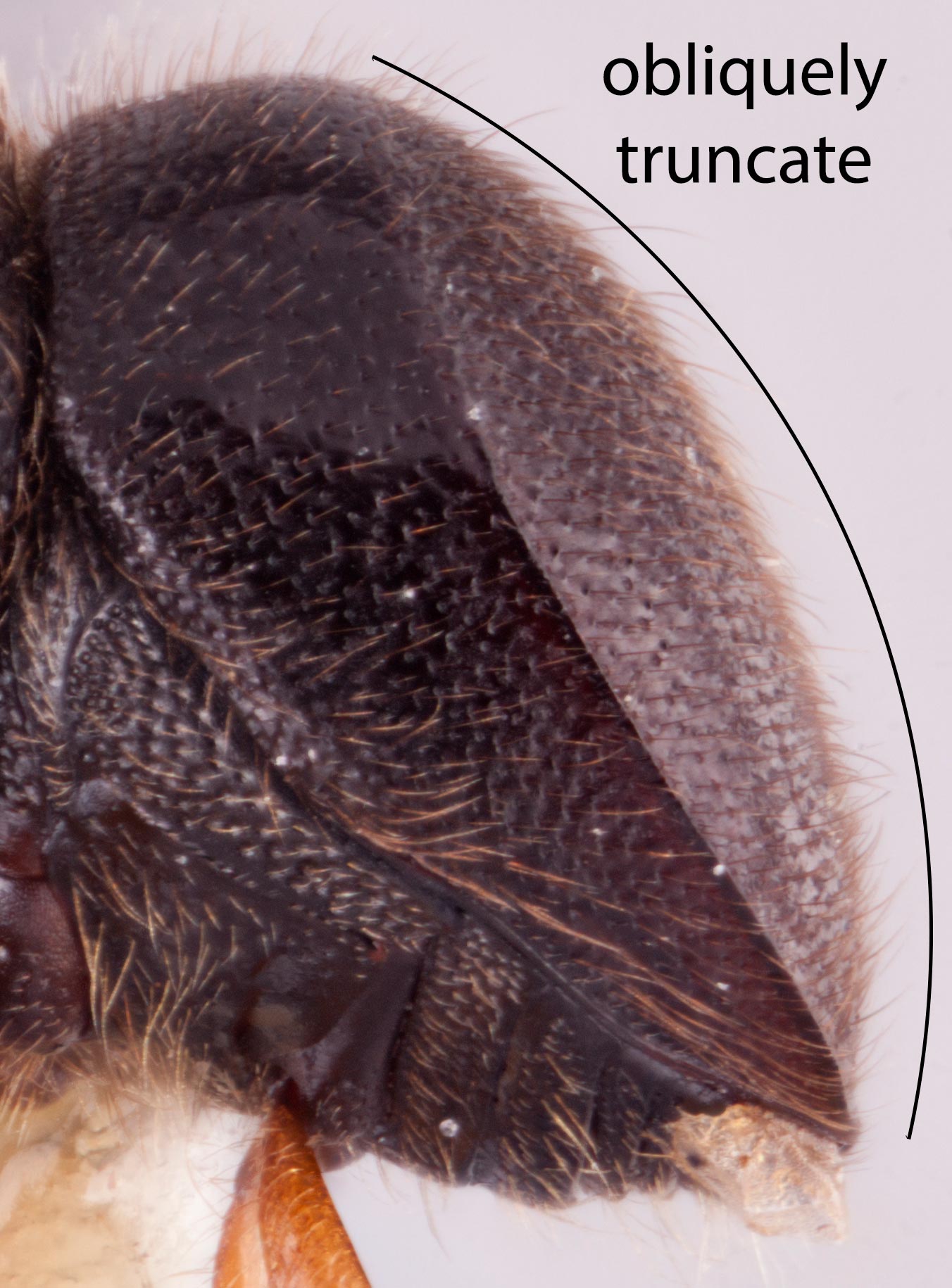Cyclorhipidion pelliculosum
|
Cyclorhipidion pelliculosum lateral; R.K. Osborn |
|
Cyclorhipidion pelliculosum dorsal; R.K. Osborn |
|
Cyclorhipidion pelliculosum declivity; R.K. Osborn |
|
Cyclorhipidion pelliculosum frontal; R.K. Osborn |
Taxonomic history
Xyleborus pelliculosus Eichhoff, 1878a: 392.
Cyclorhipidion pelliculosum (Eichhoff): Hulcr and Cognato, 2010a: 12.
Synonyms
Xyleborus seiryorensis Murayama, 1930: 25. Knížek, 2011: 243.
Xyleborus quercus Kurentzov, 1948: 51. Knížek, 2011: 243.
Xyleborus starki Nunberg, 1956: 209. New name for X. quercus Kurentzov nec Hopkins 1915. Knížek, 2011: 243.
Xyleborus okinosenensis Murayama, 1961: 31. Smith et al. 2022b: 158.
Diagnosis
3.2−3.5 mm long (mean = 3.3 mm; n = 5); 2.67−3.0 times as long as wide. This species is distinguished by the short, steep declivitydeclivity:
downward slope of either the pronotum or elytra
 that is approximately 25% of total elytralelytral:
that is approximately 25% of total elytralelytral:
pertaining to the elytra
length, armed with large tuberclestubercle:
a small knob-like or rounded protuberance of the exoskeleton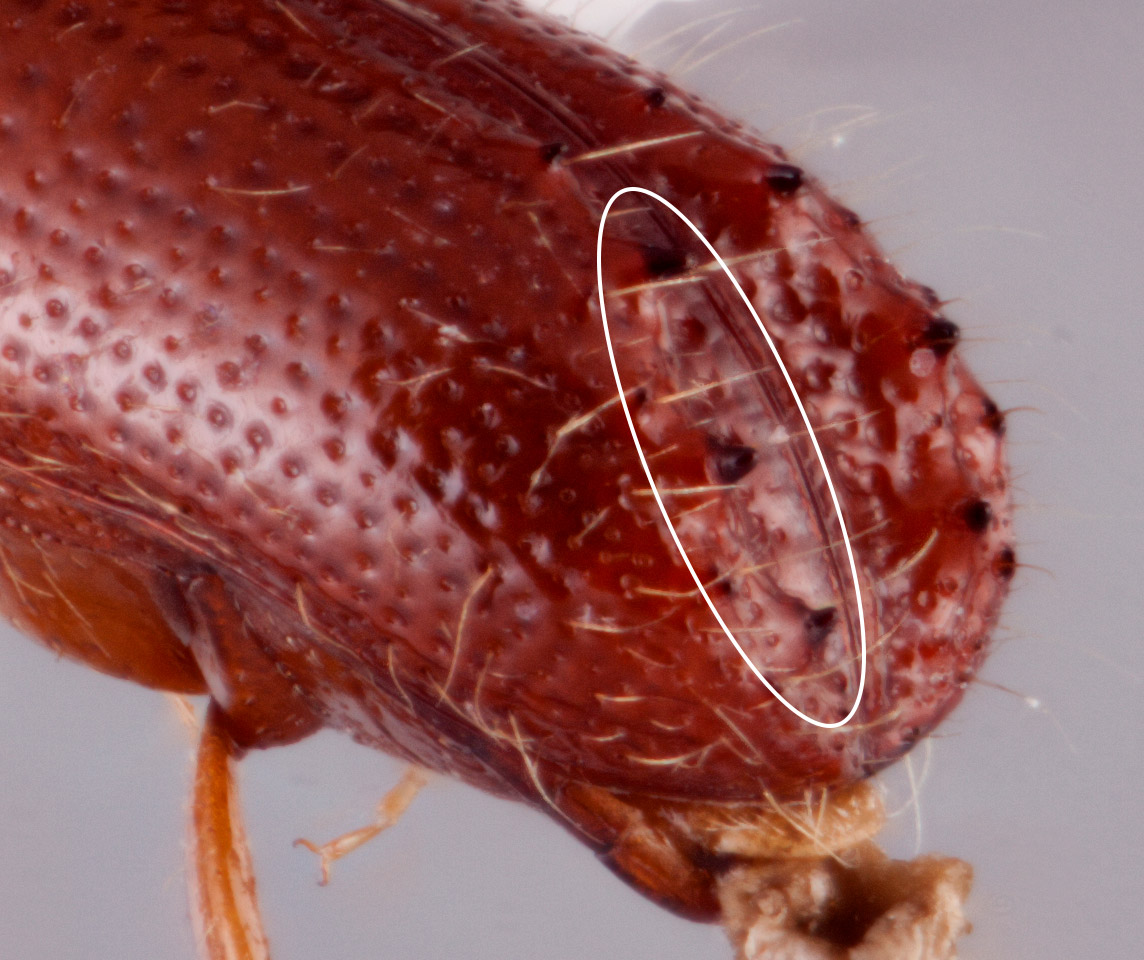 on interstriaeinterstria:
on interstriaeinterstria:
longitudinal spaces along the elytra between the striae, which is not as<br />
impressed and bear smaller punctures.
 1 and 3, interstriaeinterstria:
1 and 3, interstriaeinterstria:
longitudinal spaces along the elytra between the striae, which is not as<br />
impressed and bear smaller punctures.
 2 always unarmed; posterolateralposterolateral:
2 always unarmed; posterolateralposterolateral:
relating to end of the side part/portion
 margins rounded; and declivitaldeclivital:
margins rounded; and declivitaldeclivital:
pertaining to the elytral declivity
interstriae 1 setaeseta:
small hair-like or scale-like structure
in 3 confusedconfused:
of markings, having indefinite outlines or running together as lines or spots without definite pattern; usually referring to punctures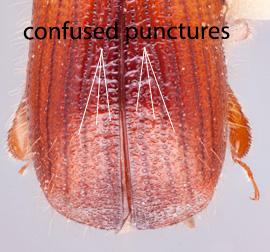 rows, interstriaeinterstria:
rows, interstriaeinterstria:
longitudinal spaces along the elytra between the striae, which is not as<br />
impressed and bear smaller punctures.
 2 setaeseta:
2 setaeseta:
small hair-like or scale-like structure
uniseriate.
May be confused with
This species most closely resembles C. distinguendum and C. triste.
This species is a part of the challenging C. pelliculosum species group. Species in the group are most easily distinguished by the rows of setaeseta:
small hair-like or scale-like structure
along declivitaldeclivital:
pertaining to the elytral declivity
interstriae 1and 2. See table below:
|
species |
declivital declivital: |
declivital declivital: |
total body length (mm) |
total body length/width ratio |
lateral lateral: |
interstriae 2 granules |
interstriae 1 & 3 granules |
|
C. achlys Smith, Beaver, and Cognato, 2022 |
3 |
1 |
3.4 |
3.09 |
steeply rounded |
absent |
present |
|
C. beaveri Lin and Smith, 2022 |
1 |
1 |
1.68−1.85 |
2.91−3.05 |
steeply rounded |
present |
present |
|
2 |
1 |
1.6−2.4 |
2.5−3.29 |
steeply rounded |
absent |
present |
|
|
2 |
2 |
2.2 |
3.14 |
steeply rounded |
absent |
present |
|
|
C. cognatoi Lin and Smith, 2022 |
2 |
1 |
2.95−3.28 |
2.82−2.93 |
steeply rounded |
absent |
present |
|
3 |
2 |
2.5−3.11 |
2.6−3.0 |
steeply rounded |
absent |
present |
|
|
2 |
1 |
2.75−3.0 |
2.75−3.0 |
steeply rounded |
absent |
present |
|
|
1 |
1 |
2−2.2 |
2.75−3.07 |
steeply rounded |
absent |
present |
|
|
C. pelliculosum |
3 |
1 |
3.2−3.5 |
2.67−3.0 |
steeply rounded |
rare, on basalbase: |
present |
|
C. taedulum Smith, Beaver, and Cognato, 2022 |
2 |
1 |
2.7 |
3 |
steeply rounded |
absent |
present |
|
2 |
2 |
2.7−3.0 |
2.5−3.0 |
steeply rounded |
Often on apicalapex: |
present |
|
|
2 |
1 |
2.92−3.47 |
2.78 |
steeply rounded |
absent |
absent |
|
|
1 |
1 |
1.65−1.8 |
3.09−3.4 |
obliquely truncateobliquely truncate: |
absent |
present |
Distribution
Native to China (Shanxi, Sichuan), Japan, South & North Korea, Russia (Far East), and Taiwan. Imported to USA (Atkinson et al. 1990Atkinson et al. 1990:
Atkinson TH, Rabaglia RJ, Bright DE. 1990. Newly detected exotic species of Xyleborus (Coleoptera: Scolytidae) with a revised key to species in eastern North America. The Canadian Entomologist 122: 92-104. https://doi.org/10.4039/Ent12293-1; Smith and Cognato 2022Smith and Cognato 2022:
Smith SM, Cognato AI. 2022. New exotic beetles found in the United States among pseudocryptic Cyclorhipidion species (Coleoptera: Curculionidae: Scolytinae: Xyleborini) revealed via a multigene phylogeny. Insect Systematics and Diversity Insect Systematics and Diversity 6(4), 2. https://doi.org/10.1093/isd/ixac014) and Canada (Ontario, Quebec) (Thurston et al. 2022Thurston et al. 2022:
Thurston GS, Slater A, Nei I, Roberts J, McLachlan Hamilton K, Sweeney JD, Kimoto T. 2022. New Canadian and provincial records of Coleoptera resulting from annual Canadian Food Inspection Agency surveillance for detection of non-native, potentially invasive forest insects. Insects 13: 708. https://doi.org/10.3390/insects13080708).
Host plants
Most records are from Castanopsis and Quercus (Fagaceae), but the species has also been recorded from Acer (Aceraceae), Juglans (Juglandaceae), and from Alnus and Betula (Betulaceae) (Mandelshtam et al. 2018Mandelshtam et al. 2018:
Mandelshtam M Yu, Yakushkin EA, Petrov AV. 2018. Oriental ambrosia beetles (Coleoptera: Curculionidae: Scolytinae): new inhabitants of Primorsky krai in Russia. Russian Journal of Biological Invasions 9(4): 355-365. https://doi.org/10.1134/S2075111718040082; Smith et al. 2020bSmith et al. 2020b:
Smith SM, Beaver RA, and Cognato AI. 2020b. A monograph of the Xyleborini (Coleoptera, Curculionidae, Scolytinae) of the Indochinese Peninsula (except Malaysia) and China. ZooKeys 983: 1-442. https://doi.org/10.3897/zookeys.983.52630)
DNA data
Sequences available for COI and CAD.
COI: GU808702; OM866994; OM866995; OM866996; OM866998; OM867001; OM867002; OM867003; OM867004
CAD: GU808624; OM891114; OM891115; OM891116; OM891118; OM891121; OM891122; OM891123; OM891124

